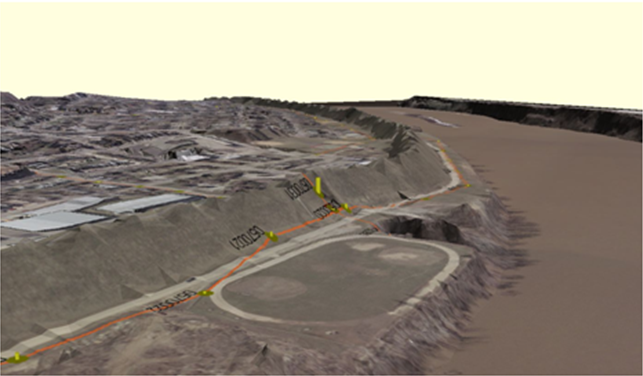March 30, 2013
Everyone knows that wastewater flows downhill but how does it flow through more than 1,000 miles of piping within the City’s collection system to the Metro Waste Water Treatment Plant (WWTP)? The City has recently initiated a project under the Clean Water 2020 Program to construct a computer simulation of the wastewater collection system. Known as a hydraulic model, this simulation tool will help the City better understand capacity limitations throughout the system and better plan for capital and operations improvements to ensure sufficient long-term capacity. It is one more component in the Clean Water 2020 program to improve and enhance the operation and function of the City’s wastewater collection system. The City has hired Hazen and Sawyer to develop the hydraulic model and to use the model to evaluate the collection system.

Hydraulic models solve complex mathematical equations to determine flow rates and pressure conditions within piping systems and, thus, allow examination of everything from the capacity of a certain pipe, to where manhole overflows could occur, to how the system will respond after an intense rain storm. As such, the computer-based hydraulic model will allow the City to test different flow conditions and potential changes within the system without actually having to conduct expensive testing in the field. Understanding how the system will perform under various flow conditions and how much capacity is in the existing system will better allow the City to optimize operations and plan for capital improvements to address system limitations.

There are several major tasks that will need to be completed to develop the hydraulic model of the City’s sewer system. These tasks include data collection, physical model development, model flow development, model calibration, and model verification. A lot of information is needed to build a sewer hydraulic model. This information includes pipe locations, pipe diameters, pump station information, pipe elevations, system flow data, and historical rainfall intensity, to name a just a portion the data currently being collected. Brown and Caldwell is leading a team of engineers and consultants to gather physical system information and flow data for the City’s sewer system. This information is critical to the model development and needs to be accurate. The better information the City has to build the hydraulic model, the more accurate are the predictions of the model and the more able the City is to make important decisions about line sizes and pump station capacities.
After data collection, the next step is to build a physical model of the system within the hydraulic modeling software. The City’s hydraulic model will include all pipes 15-inches in diameter and larger and will include pump stations that receive flow from gravity lines 15-inches or larger or that discharge into force mains 15-inches or larger. The piping and pump station network is modeled using GIS, CAD, and other computer resources and includes the many system characteristics, such as pipe elevations, mentioned above. Pipe connectivity is then validated within the software.

Population projections, customer billing data, and industrial/commercial wastewater discharge data are used to assign wastewater flows to specific areas (and specific manholes or pump stations) within the collection system. In addition, throughout many months in 2012, the City has been collecting flow data using over 60 flow meters strategically located throughout the system. Potential rainfall runoff that might make its way into the sewer system is predicted using rainfall data, age of the system, and other parameters. Together, all of this flow data is used in the model flow development, model calibration, and model verification tasks.
By using the model to consider both current flows and projected future flow increases, the City will be able to determine required capacity improvements, to develop a sewer system capital improvement plan, and to manage future system capacity. As part of this same project, a Capacity Assurance Program (CAP) will define the process by which the City will assure available system capacity in the future. This program will outline the processes for evaluating and approving additional sewer flows as well as define when improvements are needed to maintain adequate capacity.
Hydraulic model construction, system evaluation, and capacity assurance process development will be completed over the next three years with multiple reports and status updates delivered throughout. This project represents a major investment by the City and the results will help the City achieve the following objectives:
-
Develop a comprehensive knowledge-base of the current system capacity
-
Develop a sewer system hydraulic model that can be used now and in the future to make system improvement decisions
-
Minimize all capacity-related overflows (SSOs)
-
Develop a strategic plan for bolstering system capacity and performance
-
Define and develop a process to review and approve future system flow requests
All of the members of the Clean Water 2020 program are looking forward to the results of this model and are proud to be helping the City ensure long-term capacity and cost-effective planning for the wastewater collection and treatment system.